#3D-bounding-box-annotation-services
Explore tagged Tumblr posts
Text
https://pixelannotation.com/3d-bounding-box-annotation/
0 notes
Text
Title: Image Annotation Services Explained: Tools, Techniques & Use Cases
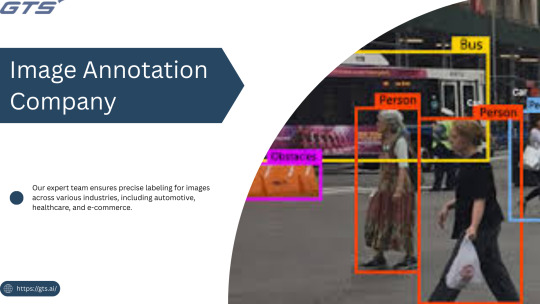
Introduction
In the fast-paced realm of artificial intelligence, Image Annotation Company serve as the foundation for effective computer vision models. Whether you are creating a self-driving vehicle, an AI-driven medical diagnostic application, or a retail analytics solution, the availability of high-quality annotated images is crucial for training precise and dependable machine learning models. But what precisely are image annotation services, how do they function, and what tools and methodologies are utilized? Let us explore this in detail.
What Is Image Annotation?
Image annotation refers to the practice of labeling or tagging images to facilitate the training of machine learning and deep learning models. This process includes the identification of objects, boundaries, and features within images, enabling AI systems to learn to recognize these elements in real-world applications. Typically, this task is carried out by specialized image annotation firms that employ a combination of manual and automated tools to guarantee precision, consistency, and scalability.
Common Image Annotation Techniques
The appropriate annotation method is contingent upon the specific requirements, complexity, and nature of the data involved in your project. Among the most prevalent techniques are:
Bounding Boxes:
Utilized for identifying and localizing objects by encasing them in rectangular boxes, this method is frequently applied in object detection for autonomous vehicles and security systems.
Polygon Annotation:
Best suited for objects with irregular shapes, such as trees, buildings, or road signs, this technique allows for precise delineation of object edges, which is essential for detailed recognition tasks.
Semantic Segmentation:
This approach assigns a label to every pixel in an image according to the object class, commonly employed in medical imaging, robotics, and augmented/virtual reality environments.
Instance Segmentation:
An advancement over semantic segmentation, this method distinguishes between individual objects of the same class, such as recognizing multiple individuals in a crowd.
Keypoint Annotation:
This technique involves marking specific points on objects and is often used in facial recognition, human pose estimation, and gesture tracking.
3D Cuboids:
This method enhances depth perception in annotation by creating three-dimensional representations, which is vital for applications like autonomous navigation and augmented reality.
Popular Image Annotation Tools
Image annotation can be executed utilizing a diverse array of platforms and tools. Notable examples include:
LabelImg: An open-source tool designed for bounding box annotations,
CVAT: A web-based application created by Intel for intricate tasks such as segmentation and tracking,
SuperAnnotate: A robust tool that merges annotation and collaboration functionalities,
Labelbox: A comprehensive platform featuring AI-assisted labeling, data management, and analytics,
VGG Image Annotator (VIA): A lightweight tool developed by Oxford for efficient annotations.
Prominent annotation service providers like GTS.AI frequently employ a blend of proprietary tools and enterprise solutions, seamlessly integrated with quality assurance workflows to fulfill client-specific needs.
Real-World Use Cases of Image Annotation
Image annotation services play a vital role in various sectors, including:
Autonomous Vehicles
Object detection for identifying pedestrians, vehicles, traffic signs, and road markings.
Lane detection and semantic segmentation to facilitate real-time navigation.
Healthcare
Annotating medical images such as X-rays and MRIs to identify tumors, fractures, or other abnormalities.
Training diagnostic tools to enhance early disease detection.
Retail and E-commerce:
Implementing product identification and classification for effective inventory management.
Monitoring customer behavior through in-store camera analytics.
Agriculture:
Assessing crop health, detecting pests, and identifying weeds using drone imagery.
Forecasting yield and optimizing resource allocation.
Geospatial Intelligence:
Classifying land use and mapping infrastructure.
Utilizing annotated satellite imagery for disaster response.
Why Work with a Professional Image Annotation Company?
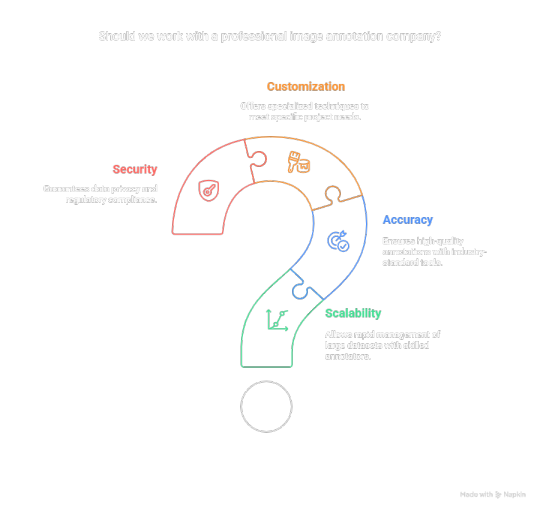
Although in-house annotation may initially appear feasible, expanding it necessitates significant time, resources, and a comprehensive quality assurance process. This is the reason businesses collaborate with providers such as GTS.AI:
Scalability : Allows for the rapid management of extensive datasets through skilled annotators;
Accuracy : Is ensured with industry-standard tools and quality assurance measures;
Customization : Coffers specialized annotation techniques to meet specific project objectives; and
Security : Guarantees adherence to data privacy regulations for sensitive data.
Final Thoughts
With the expansion of AI and computer vision applications, the necessity for high-quality annotated data has become increasingly vital. Image annotation services have evolved from being merely supportive functions to becoming strategic assets essential for developing dependable AI systems. If you aim to enhance your AI projects through professional data labeling, consider Globose Technology Solution .AI’s Image and Video Annotation Services to discover how they can effectively assist you in achieving your objectives with accuracy, efficiency, and scalability.
0 notes
Text
Video Annotation Services: Enhancing AI with Superior Training Data
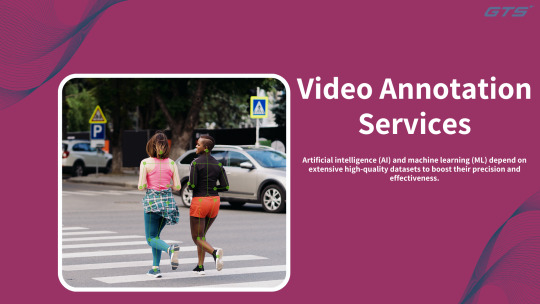
Introduction:
Artificial intelligence (AI) and machine learning (ML) depend on extensive high-quality datasets to boost their precision and effectiveness. A vital aspect of this endeavor is Video Annotation Services, a method employed to label and categorize various objects, actions, and events within video content. By supplying AI models with meticulously annotated video data, organizations can refine their AI solutions, rendering them more intelligent and dependable.
What is Video Annotation?
Video annotation refers to the process of appending metadata to video frames to facilitate the training of AI and ML algorithms. This process includes tagging objects, monitoring movements, and supplying contextual information that aids AI systems in comprehending and interpreting visual data. It is crucial for various applications, including autonomous driving, medical imaging, security surveillance, and beyond.
The Importance of High-Quality Training Data
The performance of AI models is significantly influenced by the quality of the data utilized for training. Inaccurately labeled or subpar data can result in erroneous predictions and unreliable AI outcomes. High-quality video annotation guarantees that AI models can:
Precisely identify and categorize objects.
Monitor movements and interactions within a scene.
Enhance real-time decision-making abilities.
Minimize errors and reduce false positives.
Essential Video Annotation Techniques
Bounding Boxes – These are utilized to outline objects within a video frame using rectangular shapes.
Semantic Segmentation – This technique involves labeling each pixel in a frame to achieve precise object identification.
Polygon Annotation – This method creates accurate boundaries around objects with irregular shapes.
Keypoint and Landmark Annotation – This identifies specific points on objects, facilitating facial recognition and pose estimation.
3D Cuboid Annotation – This technique incorporates depth information for artificial intelligence models applied in robotics and augmented/virtual reality environments.
The Role of Video Annotation Services in Advancing AI Applications
Autonomous Vehicles
Video annotation plays a vital role in training autonomous vehicles to identify pedestrians, other vehicles, traffic signals, and road signs.
Healthcare and Medical Imaging
AI-driven diagnostic tools depend on video annotation to identify irregularities in medical scans and to observe patient movements.
Security and Surveillance
AI-enhanced surveillance systems utilize annotated videos to recognize suspicious behavior, monitor individuals, and improve facial recognition capabilities.
Retail and Customer Analytics
Retailers employ video annotation to study customer behavior, monitor foot traffic, and enhance store layouts.
Reasons to for Professional Video Annotation Services
Engaging expert video annotation services offers several advantages:
Enhanced Accuracy – Skilled annotators deliver meticulous data labeling, minimizing errors during AI training.
Scalability – Professional services are equipped to manage extensive datasets with ease.
Cost Efficiency – Outsourcing annotation tasks conserves time and resources by negating the necessity for internal annotation teams.
Tailored Solutions – Customized annotation methods designed for specific sectors and AI applications.
Your Reliable Partner for Video Annotation
At we offer premier video annotation services aimed at equipping AI with high-quality training data. Our expert team guarantees precise and scalable annotations across diverse industries, assisting businesses in developing more intelligent AI models.
Why Select video annotation
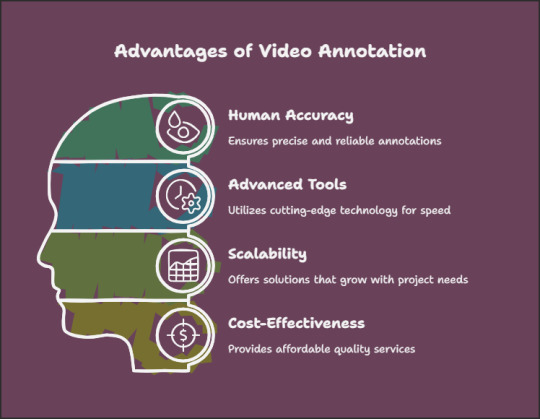
Proficient human annotators ensuring accuracy.
State-of-the-art annotation tools for expedited processing.
Scalable solutions customized to meet your project requirements.
Affordable pricing without sacrificing quality.
In Summary
Video annotation services are fundamental to AI training, ensuring that models are trained on high-quality, accurately labeled data. Whether your focus is on autonomous systems, healthcare AI, or security applications, investing in professional video annotation services like those offered by Globose Technology Solutions will significantly improve the accuracy and effectiveness of your AI solutions.
0 notes
Text
Image Annotation: The Backbone of AI and Machine Learning
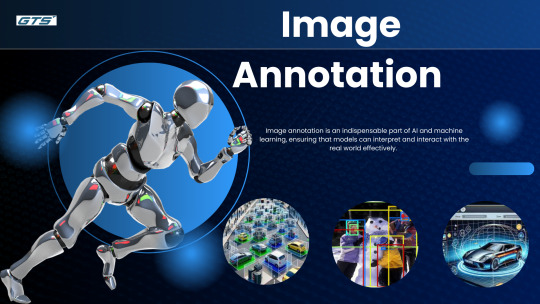
Introduction
Image Annotation serves as an essential component in the domains of artificial intelligence (AI) and machine learning (ML), facilitating the ability of machines to identify and interpret images with a level of accuracy akin to that of humans. This process is vital in various applications, ranging from autonomous vehicles to healthcare diagnostics, as it significantly contributes to the training of AI models in comprehending the visual environment.
What is Image Annotation?
Image annotation involves the systematic labeling of images with relevant metadata, thereby rendering them comprehensible to machine learning algorithms. These annotations enable AI models to detect objects, discern patterns, and recognize other features within an image. The precision of these annotations is crucial, as it directly influences the effectiveness of AI applications, underscoring its importance in the data preprocessing phase.
Types of Image Annotation
Various techniques are employed in image annotation, each designed for specific applications in artificial intelligence:
Bounding Box Annotation – This approach entails drawing rectangular boxes around objects, facilitating the detection and recognition of these objects by AI models. It is commonly utilized in object detection scenarios, such as identifying pedestrians in autonomous vehicles.
Semantic Segmentation – Rather than labeling entire objects, this technique assigns a class to each pixel within an image, enabling precise delineation of object boundaries. It is particularly beneficial in fields like medical imaging and satellite image analysis.
Keypoint Annotation – This technique involves marking specific points on objects, such as facial landmarks or human skeletal joints, which is essential for applications like facial recognition and pose estimation.
Polygon Annotation – In contrast to bounding boxes, polygon annotation offers more accurate representations of object outlines, making it suitable for identifying irregularly shaped objects, such as buildings in aerial photographs.
3D Cuboid Annotation – This method incorporates a three-dimensional perspective into objects, enhancing depth perception for AI models and aiding autonomous systems in better understanding their environment.
Polyline Annotation – This technique is utilized to indicate linear features, such as road lanes, thereby assisting self-driving vehicles in navigating effectively.
Applications of Image Annotation

Image annotation serves as a crucial element in various AI-driven sectors. Notable applications include:
Autonomous Vehicles – Self-driving technology utilizes annotated images to identify pedestrians, other vehicles, traffic signals, and potential hazards.
Healthcare – Medical AI applications leverage annotated images to identify diseases, support diagnostic processes, and improve interpretations in radiology.
Retail & E-commerce – Image recognition technology facilitates visual searches, enhances product recommendations, and streamlines automated checkout processes.
Security & Surveillance – High-quality image annotation is essential for facial recognition and anomaly detection in surveillance systems.
Agriculture – AI-enabled drones utilize annotated images of crops to evaluate health conditions and forecast yields.
Why Opt for Professional Image Annotation Services?
Manual image annotation is labor-intensive and demands a high level of accuracy. Companies such as GTS.AI focus on delivering superior image and video annotation services to guarantee precise training of AI models. Their proficiency in managing intricate annotation tasks aids businesses in optimizing AI development and enhancing model efficacy.
Conclusion
Image annotation plays a crucial role in the fields of artificial intelligence and machine learning, enabling models to accurately understand and engage with the real world. This process is vital across various applications, including autonomous vehicles, healthcare, and security, as high-quality image annotation contributes to the development of more precise and dependable AI systems. Engaging professional annotation services can greatly improve the performance of AI models, resulting in enhanced decision-making and automation capabilities.
For further information regarding image annotation services, please visit Globose Technology Solutions.
0 notes
Text
The Best Labelbox Alternatives for Data Labeling in 2025
Whether you're training machine learning models, building AI applications, or working on computer vision projects, effective data labeling is critical for success. Labelbox has been a go-to platform for enterprises and teams looking to manage their data labeling workflows efficiently. However, it may not suit everyone’s needs due to high pricing, lack of certain features, or compatibility issues with specific use cases.
If you're exploring alternatives to Labelbox, you're in the right place. This blog dives into the top Labelbox alternatives, highlights the key features to consider when choosing a data labeling platform, and provides insights into which option might work best for your unique requirements.
What Makes a Good Data Labeling Platform?
Before we explore alternatives, let's break down the features that define a reliable data labeling solution. The right platform should help optimize your labeling workflow, save time, and ensure precision in annotations. Here are a few key features you should keep in mind:
Scalability: Can the platform handle the size and complexity of your dataset, whether you're labeling a few hundred samples or millions of images?
Collaboration Tools: Does it offer features that improve collaboration among team members, such as user roles, permissions, or integration options?
Annotation Capabilities: Look for robust annotation tools that support bounding boxes, polygons, keypoints, and semantic segmentation for different data types.
AI-Assisted Labeling: Platforms with auto-labeling capabilities powered by AI can significantly speed up the labeling process while maintaining accuracy.
Integration Flexibility: Can the platform seamlessly integrate with your existing workflows, such as TensorFlow, PyTorch, or custom ML pipelines?
Affordability: Pricing should align with your budget while delivering a strong return on investment.
With these considerations in mind, let's explore the best alternatives to Labelbox, including their strengths and weaknesses.
Top Labelbox Alternatives
1. Macgence
Strengths:
Offers a highly customizable end-to-end solution that caters to specific workflows for data scientists and machine learning engineers.
AI-powered auto-labeling to accelerate labeling tasks.
Proven expertise in handling diverse data types, including images, text, and video annotations.
Seamless integration with popular machine learning frameworks like TensorFlow and PyTorch.
Known for its attention to data security and adherence to compliance standards.
Weaknesses:
May require time for onboarding due to its vast range of features.
Limited online community documentation compared to Labelbox.
Ideal for:
Organizations that value flexibility in their workflows and need an AI-driven platform to handle large-scale, complex datasets efficiently.
2. Supervisely
Strengths:
Strong collaboration tools, making it easy to assign tasks and monitor progress across teams.
Extensive support for complex computer vision projects, including 3D annotation.
A free plan that’s feature-rich enough for small-scale projects.
Intuitive user interface with drag-and-drop functionality for ease of use.
Weaknesses:
Limited scalability for larger datasets unless opting for the higher-tier plans.
Auto-labeling tools are slightly less advanced compared to other platforms.
Ideal for:
Startups and research teams looking for a low-cost option with modern annotation tools and collaboration features.
3. Amazon SageMaker Ground Truth
Strengths:
Fully managed service by AWS, allowing seamless integration with Amazon's cloud ecosystem.
Uses machine learning to create accurate annotations with less manual effort.
Pay-as-you-go pricing, making it cost-effective for teams already on AWS.
Access to a large workforce for outsourcing labeling tasks.
Weaknesses:
Requires expertise in AWS to set up and configure workflows.
Limited to AWS ecosystem, which might pose constraints for non-AWS users.
Ideal for:
Teams deeply embedded in the AWS ecosystem that want an AI-powered labeling workflow with access to a scalable workforce.
4. Appen
Strengths:
Combines advanced annotation tools with a global workforce for large-scale projects.
Offers unmatched accuracy and quality assurance with human-in-the-loop workflows.
Highly customizable solutions tailored to specific enterprise needs.
Weaknesses:
Can be expensive, particularly for smaller organizations or individual users.
Requires external support for integration into custom workflows.
Ideal for:
Enterprises with complex projects that require high accuracy and precision in data labeling.
Use Case Scenarios: Which Platform Fits Best?
For startups with smaller budgets and less complex projects, Supervisely offers an affordable and intuitive entry point.
For enterprises requiring precise accuracy on large-scale datasets, Appen delivers unmatched quality at a premium.
If you're heavily integrated with AWS, SageMaker Ground Truth is a practical, cost-effective choice for your labeling needs.
For tailored workflows and cutting-edge AI-powered tools, Macgence stands out as the most flexible platform for diverse projects.
Finding the Best Labelbox Alternative for Your Needs
Choosing the right data labeling platform depends on your project size, budget, and technical requirements. Start by evaluating your specific use cases—whether you prioritize cost efficiency, advanced AI tools, or integration capabilities.
For those who require a customizable and AI-driven data labeling solution, Macgence emerges as a strong contender to Labelbox, delivering robust capabilities with high scalability. No matter which platform you choose, investing in the right tools will empower your team and set the foundation for successful machine learning outcomes.
Source: - https://technologyzon.com/blogs/436/The-Best-Labelbox-Alternatives-for-Data-Labeling-in-2025
0 notes
Text
The Role of an Image Annotation Company in Enhancing AI Precision

Introduction
The effectiveness of Artificial Intelligence (AI) is fundamentally dependent on the quality of the data it processes, with Image Annotation Company being pivotal in elevating AI precision. Whether in autonomous vehicles, medical diagnostics, or online retail, AI systems require accurately labeled images to operate optimally. This is where an image annotation company can significantly contribute.
The Significance of Quality Image Annotation
For AI to accurately interpret and analyze visual information, it necessitates labeled images that convey valuable insights. High-quality annotations enable machine learning models to:
Precisely identify objects.
Distinguish between similar items.
Recognize anomalies in intricate settings.
Enhance decision-making based on real-world contexts.
Methods to Improve AI Precision
An image annotation company utilizes a variety of methods to boost AI precision, including:
Bounding Boxes: Essential for object detection, bounding boxes assist AI models in identifying and locating objects within images.
Semantic Segmentation: This technique divides an image into various regions, allowing AI to recognize distinct objects and comprehend contextual relationships.
Key Points and Landmark Annotation: Crucial for applications in facial recognition and pose estimation.
3D Cuboids: Employed in autonomous vehicles and robotics to facilitate depth perception and spatial awareness.
Polygon Annotation: For objects with irregular shapes, polygons provide detailed outlines, enhancing accuracy in object recognition.
The Impact of Image Annotation on AI Performance
AI models require extensive labeled data to refine their algorithms and reduce errors. By collaborating with an image annotation company, organizations can:
Improve Model Training: Well-annotated images accelerate AI learning and enhance accuracy.
Mitigate Bias in AI: Ensuring diverse and unbiased datasets fosters fairer AI predictions.
Boost Automation Efficiency: High-quality data annotations enhance the effectiveness of AI automation.
Industries Benefiting from Image Annotation
The demand for accurate image annotation is prevalent across various sectors:
Autonomous Vehicles – Self-driving cars powered by artificial intelligence depend on annotated images for tasks such as object recognition, lane detection, and identifying pedestrians.
Healthcare & Medical Imaging – Annotated medical images, including X-rays, MRIs, and CT scans, play a crucial role in diagnosing diseases and facilitating medical assessments.
Retail & E-Commerce – Features like product tagging and visual search enhance the online shopping experience for consumers.
Agriculture – AI-based solutions for monitoring crops, detecting pests, and predicting yields are supported by annotated images in the agricultural sector.
Why Collaborate with an Image Annotation Company?
Collaborating with a specialized image annotation company guarantees high levels of accuracy, consistency, and scalability. Professional annotation services offer:
Access to experienced annotators with relevant industry knowledge.
State-of-the-art annotation tools and rigorous quality control processes.
Scalable solutions capable of efficiently managing large datasets.
Conclusion
Artificial intelligence models significantly depend on well-annotated images to operate effectively. By partnering with a professional image annotation company, organizations can ensure their AI systems are equipped with high-quality data, resulting in enhanced accuracy, improved decision-making, and greater efficiency. Whether in healthcare, automotive, or retail, investing in superior image annotation is essential for realizing the full potential of AI.
How GTS.AI Make Your Project Complete?
Globose Technology Solutions is integral to our professional environment, offering high-quality, scalable, and accurate image annotation solutions that support AI models across various sectors. Its sophisticated annotation tools—including bounding boxes, semantic segmentation, and 3D cuboids—guarantee precision in training datasets for applications such as autonomous vehicles, healthcare diagnostics, and e-commerce. By utilizing AI-assisted annotation, automated quality control, and a proficient workforce, gts.ai improves efficiency, minimizes bias, and expedites AI development. Its cloud-based workflow facilitates seamless collaboration, enhancing the reliability and effectiveness of AI training, and ultimately influencing the future of intelligent automation.!
1 note
·
View note
Text
Image Data Annotation for Agriculture: Revolutionizing Crop Monitoring
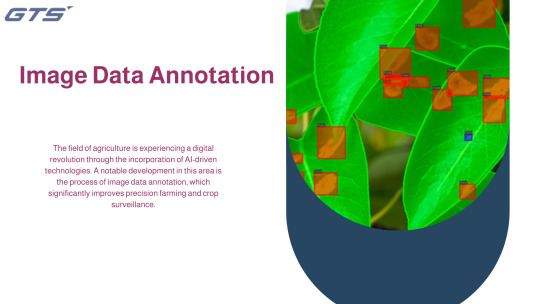
Introduction
The field of agriculture is experiencing a digital revolution through the incorporation of AI-driven technologies. A notable development in this area is the process of Image Data Annotation, which significantly improves precision farming and crop surveillance. Utilizing annotated images from agriculture, AI models are capable of assessing crop health, identifying diseases, and refining yield predictions.
What is Image Data Annotation in Agriculture?
Image data annotation in agriculture refers to the process of labeling visual information, including satellite imagery, drone captures, and photographs of fields, to facilitate the training of machine learning models tailored for agricultural purposes. These annotations enable artificial intelligence systems to detect patterns, classify crop types, and evaluate field conditions with a high degree of precision.
Categories of Image Data Annotation in Agriculture:
1. Bounding Box Annotation – This method identifies plants, weeds, and pests to enable automated detection.
2. Semantic Segmentation – This technique distinguishes between crops, soil, and weeds within an image.
3. Keypoint Annotation – This approach marks essential points on plants to monitor their growth.
4. Polygon Annotation – This method provides accurate outlines of fields and crop areas.
5. 3D Cuboid Annotation – This technique assists in estimating the height and structure of plants.
How Image Data Annotation is Transforming Crop Monitoring
1. Enhanced Crop Health Assessment
AI-driven models utilize annotated images to identify early indicators of diseases, nutrient shortages, and pest problems, allowing farmers to take timely action.
2. Identification of Weeds and Pests
Automated systems for weed detection leverage annotated datasets to differentiate between crops and harmful plants, minimizing the necessity for manual weeding and reducing pesticide application.
3. Yield Forecasting and Harvest Efficiency
Through the analysis of annotated images, AI models can project crop yields, enabling farmers to organize harvest timelines effectively and enhance overall productivity.
4. Targeted Irrigation and Soil Assessment
Image data annotation aids AI-based irrigation systems by monitoring soil moisture and plant hydration levels, promoting efficient water management.
5. Adaptation to Climate and Weather Changes
Utilizing annotated climate and weather data, AI models can foresee unfavorable conditions, assisting farmers in taking preventive actions against droughts or severe weather events.
The Importance of Professional Data Annotation Services
High-quality image annotation services, such as those offered by GTS AI, play a crucial role in the effective training of AI models. These services provide:
Scalability – The ability to manage extensive volumes of agricultural data with efficiency.
Accuracy – Superior annotations that enhance the precision of models.
Cost Efficiency – Minimizing manual labor expenses in the agricultural sector.
Customization – Bespoke annotation solutions tailored to meet specific agricultural requirements.
Conclusion
Image data annotation is revolutionizing the agricultural landscape by facilitating AI-driven crop monitoring, disease identification, and yield forecasting. As technological advancements continue, precision farming will further develop, equipping farmers with data-informed insights for sustainable agricultural practices.
For innovative image annotation solutions, consider GTS AI to transform your agricultural AI models today.
0 notes
Text
Unleashing the Power of Image Annotation: Transforming Industries

AI and ML development are revolutionizing the business and will leapfrog emerging technologies. Image Annotation One of the key elements that empower AI systems to achieve bug-free programming is image annotation. Image annotation is the technical act of labeling images to make visual data comprehensible to machines respectively. We are offering state-of-the-art image annotation services, with a focus on the precision and accuracy of AI models based on annotated datasets. The blog highlights what image annotation is, what applications it finds, and how GTS.ai specifies innovation in the sector.
What Is Image Annotation?
Image annotation is a major architect of computer vision, a subdivision of AI, permitting machines to analyze and interpret visual data across multiple points. The algorithm dictates that the images must have corresponding labels applied to them so that they can "see" and "understand" the visuals. The methods comprise various techniques ranging from bounding boxes, polygon annotations, semantic segmentation to 3D point clouds, depending on the sophistication of the application.
Why Image Annotation is Important
In one way or the other, image annotation is pretty crucial in shaping AI applications. Its importance comes to the fore:
Training Accurate AI Models :The pictures, which have been annotated, form a database to train AI algorithms. With data, the model predicts accurate objects and can even spot anomalies.
AI Applications across Domains : From self-driving cars to diagnosis in healthcare, annotated images present functional AI solutions that blend reliability and efficiency.
Drawing Insights from the Data : Annotated images help drive actionable insights across businesses, leading to better decision-making, enhanced customer experience, and improvement in operations.
Applications of Image Annotation in Various Industries
Autonomous Vehicles : Self-driving cars are very dependent on annotated datasets to recognize pedestrians, vehicles, traffic signs, and road conditions. With annotation done right, safety and functionality are guaranteed.
Healthcare : Annotated images allow AI to track diseases, tumors, or anomalies in X-rays, MRIs, and other diagnostic tools that assist doctors in making diagnoses more efficiently and precisely.
Retail & E-Commerce : Image annotation improves visual search engines, enabling customers to search for products using images. It also helps catalog products accurately.
Agriculture : AI-based drones analyze annotated images of farmland, tracking plant health and pest detection, as well as resource optimization.
Security and Surveillance : Annotated images allow for real-time facial recognition, intrusion detection, and activity monitoring.
Robotics : Robots trained with annotated images can sort items, assemble various components, and deliver packages with precision.
GTS.ai: Everything You Need in Image Annotation
At GTS.ai, we understand that quality annotated datasets contribute greatly to the accuracy of AI models. Our team of experts employs high-end and unique techniques in delivering image annotation services tailored to your project needs. So, what makes us stand out?
Various Annotation Methods : No matter if your project requires bounding boxes, polygon annotation, or even 3D labeling, we can manage them all.
Industry-Specific Know-how : Having worked across multiple industries, we understand your unique requirements and can deliver on what you desire.
Scalability and Flexibility : With GTS.ai, a project of any size and complexity will always be developed in-time without compromise of quality.
Data Security : Confidentiality of your data is paramount-at GTS.ai; stringent protocols of security will be adhered to.
Custom Solutions : Every project is different; so are our services. We offer customized annotation services, designed according to your specifications.
Why Work With GTS.ai?
When working with GTS.ai, you will definitely be dealing with a team that is all for perfection. So, this is how we add value to your AI journey.
Cost-effective Solutions: Quality services at a competitive price point.
Human-in-the-loop Model: Human annotation precision supplements the speed of AI-assisted tools.
Global Reach: Servicing clients across industries and geographies.
24/7 Support: Support is always dedicated toward addressing your queries and ensuring project needs are aptly executed. Future of Image Annotation
As the AI MLs develop progressively, so does the demand for high-quality image annotation. AI-powered automated tools and augmented reality annotators are all collectibles of these changes toward swifter and more accurate outcomes. GTS.ai is at the forefront of such improvements, continuously improving its service features to remain ahead of the curve.
Conclusion
Image annotation forms the bedrock of AI systems which have revolutionised whole industries and opened up new vistas of possibilities. GTS.ai prides in delivering excellent image annotation services, enabling firms to leverage the full potential of AI. In these lines, whether it is being done in the progressively evolving autonomous vehicles, health sector solutions, or retail optimized manifolds, we put our mark of experience upon the training of any oriented AI models.
Do you want to enhance your AI projects? Join hands with GTS.ai and watch how excellent image annotation produces a difference. To know more, check out GTS.ai!
0 notes
Text
A Complete Guide to Choosing the Best Video Annotation Services

Introduction
Video Annotation Services serve as a fundamental component of contemporary artificial intelligence (AI) and machine learning (ML) applications, especially within the realm of computer vision. These services are essential for various applications, from facilitating autonomous vehicles to enhancing sophisticated surveillance systems, as accurately labeled video data is crucial for training AI models. Selecting an appropriate video annotation service can greatly influence the success of your AI initiatives. This guide aims to outline the essential considerations and factors to help you choose the most suitable provider for your requirements.
What Are Video Annotation Services?
Video annotation involves the labeling or tagging of elements within video content to generate structured datasets for AI and ML training. By recognizing objects, actions, and other visual components on a frame-by-frame basis, video annotation enables machines to comprehend and analyze dynamic visual information.
Applications of video annotation encompass:
Autonomous vehicles (object detection, lane tracking, pedestrian identification)
Video surveillance (detecting unusual behaviors or threats)
Healthcare (evaluating medical imaging and surgical procedures)
Retail (analyzing customer behavior)
Sports (tracking performance and analytics)
Why Are Video Annotation Services Important?
Video annotation services provide:
Accuracy: High-quality, precisely labeled data is essential for the effective performance of AI models.
Scalability: Professional services are equipped to manage substantial volumes of video data efficiently.
Expertise: Providers typically utilize advanced tools and skilled annotators to ensure accurate annotations.
Efficiency: Delegating annotation tasks allows organizations to save time and concentrate on their primary functions.
Explore GTS.AI Video Annotation Services to discover customized solutions tailored to your AI training requirements.
Considerations for Selecting Video Annotation Services
When selecting an appropriate video annotation service, it is essential to assess several key factors:
1. Expertise and Experience
Seek providers with a demonstrated track record in video annotation across diverse sectors. Evaluate:
Portfolio: Availability of case studies or examples of past projects.
Domain Knowledge: Understanding of the specific requirements pertinent to your industry.
Certifications: Compliance with industry standards and certifications that ensure data quality.
2. Annotation Techniques and Tools
Verify that the provider employs sophisticated annotation techniques and tools, including:
Bounding Boxes: Utilized for object detection.
Semantic Segmentation: For labeling at the pixel level.
3D Annotation: For capturing depth and spatial information.
Polygon Annotation: For objects with irregular shapes.
Skeleton Annotation: For estimating human poses.
Utilization of advanced AI-assisted tools can enhance efficiency and accuracy, minimizing manual labor.
3. Scalability
AI initiatives frequently involve extensive datasets. Opt for a provider capable of managing:
Large Volumes: Flexibility to scale operations according to project needs.
Quick Turnaround: Streamlined workflows to accommodate tight deadlines.
4. Data Security and Confidentiality
Ensuring data privacy is vital, particularly for sensitive projects. Confirm that the provider:
Implements robust data security protocols.
Agrees to non-disclosure agreements (NDAs) to safeguard your information.
Adheres to data privacy regulations such as GDPR or CCPA.
5. Quality Assurance
High-quality annotations are crucial for effective AI training. Look for:
Quality Control Processes: Implementation of multi-tiered reviews and validations.
Accuracy Rates: Providers that assure high levels of precision.
Error Handling: Systems in place for rectifying errors.
6. Cost-Effectiveness
Although cost is a significant consideration, it should not undermine the quality of the service. Assess the following:
Pricing Structures: Ensure pricing is clear and devoid of hidden fees.
Value Proposition: Achieve a harmonious balance between cost and quality.
7. Customization and Flexibility
Each project possesses distinct requirements. Select a provider that can offer:
Bespoke Solutions: Customized workflows and types of annotation.
Versatility: The ability to adapt to evolving project demands.
8. Communication and Support
Effective communication is vital for smooth collaboration. Seek out:
Dedicated Support Teams: Ready to assist with inquiries and provide updates.
Consistent Reporting: Mechanisms for tracking progress and receiving updates.
Collaborative Tools: Systems that facilitate real-time feedback and revisions.
Advantages of Collaborating with Professional Video Annotation Services
1. Time and Resource Efficiency
Delegating video annotation tasks enables your team to concentrate on essential AI development activities, thereby expediting project timelines.
2. Access to Expertise
Professional services utilize skilled annotators who guarantee high-quality results, even for intricate projects.
3. Improved Precision
Experienced providers utilize advanced tools and implement multi-tiered quality assurance processes to ensure accurate annotations.
4. Scalability
Professional services possess the capability to easily expand operations to accommodate the increasing demands of your project.
How to Assess Service Providers?
When selecting potential video annotation service providers, consider the following steps:

Request a Demonstration: Observe their tools and methodologies in practice.
Verify References: Seek client testimonials or reviews.
Initiate a Pilot Project: Evaluate their capabilities using a small dataset prior to engaging in larger assignments.
Compare Various Providers: Assess them based on the aforementioned criteria.
Conclusion
Selecting the appropriate video annotation service is essential for the development of effective AI models. By prioritizing expertise, scalability, data security, and quality assurance, you can ensure that your projects are supported by high-quality annotated data. Collaborating with trustworthy providers such as GTS.AI can enhance your AI initiatives with accurate and efficient video annotation solutions.
Make informed investments in the right service to position your AI systems for success in a data-driven future.
0 notes
Text
Shaping Smarter Machines: Image Annotation in the Digital Era
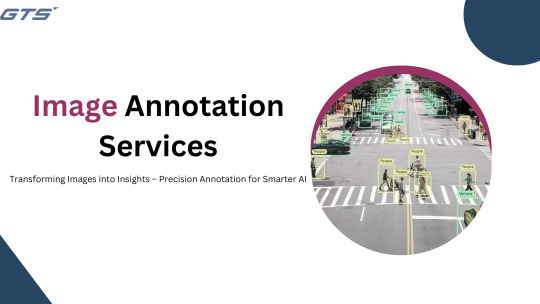
Introduction:
In the contemporary digital landscape, the distinction between human intelligence and artificial intelligence (AI) is increasingly indistinct as machines evolve to become more intelligent, rapid, and efficient. Central to this evolution is a vital yet frequently overlooked process: Image Annotation Services . This detailed practice forms the foundation of AI’s capacity to analyze, comprehend, and react to visual information. This article will delve into the essential function of image annotation in the development of advanced machines and its influence on the future of technology.
What Is Image Annotation?
Image annotation refers to the technique of tagging images with metadata to render them comprehensible to machines. This process includes marking objects, identifying characteristics, or delineating boundaries within an image, thereby converting raw data into formats that machines can interpret. These annotations provide the training data necessary for machine learning models, particularly in domains such as computer vision, where the ability to understand visual content is critical.
Common types of image annotation encompass:
Bounding Boxes: Drawing rectangles around objects to indicate their position.
Semantic Segmentation: Segmenting an image into parts to assign labels to individual pixels.
Polygons: Outlining intricate shapes for precise object detection.
Keypoint Annotation: Identifying specific points, such as facial features or joint locations.
3D Cuboids: Extending bounding boxes into three dimensions for depth analysis. Each type of annotation is tailored to specific machine learning applications, enabling AI systems to recognize faces, detect objects, or even facilitate the navigation of autonomous vehicles.
The Significance of Image Annotation
Annotated data is essential for AI systems, as it provides the necessary context to interpret visual information effectively. Without it, machines face challenges similar to navigating an unfamiliar country without a map or language comprehension. Image annotation serves as a crucial link by supplying structured and labeled data, allowing machines to recognize patterns and relationships.
The primary advantages of image annotation include:
Improving Accuracy: Annotated datasets enhance the precision of models, thereby minimizing errors in tasks such as object detection and image classification.
Preparing AI for Practical Use: From self-driving vehicles to medical imaging, annotated images equip AI systems for real-world applications.
Facilitating Scalability: High-quality annotations enable the expansion of AI applications across various industries.
The Role of Image Annotation in Contemporary Digital Applications
The influence of image annotation extends across multiple sectors, acting as a catalyst for innovative advancements:
Autonomous Vehicles: Self-driving technology depends on annotated images to recognize pedestrians, vehicles, traffic signs, and road boundaries. This annotation is vital for enabling these systems to make rapid decisions, thereby improving safety and operational efficiency.
Healthcare: In the realm of medical imaging, annotated data assists AI models in identifying diseases such as cancer and diabetic retinopathy. Collaboration between radiologists and data scientists is essential for labeling anomalies in scans, which leads to faster and more accurate diagnoses.
E-Commerce: Retailers utilize image annotation for tailored recommendations, visual search capabilities, and inventory management. For instance, AI can analyze user-uploaded photos to identify clothing items and suggest similar products.
Agriculture: Annotated images play a significant role in monitoring crop health, identifying pests, and maximizing yields. Drones equipped with AI technology analyze annotated visual data to deliver actionable insights to farmers.
Security and Surveillance: Annotated images are integral to facial recognition systems and anomaly detection in security cameras, enhancing monitoring capabilities.
Challenges in Image Annotation
The significance of image annotation is clear; however, it presents several challenges:
Labor-Intensive Nature: The process of annotating extensive datasets demands considerable time and careful attention to detail.
Financial Implications: Engaging professional annotation services can incur substantial costs, particularly for intricate tasks.
Variability in Interpretation: Different human annotators may perceive images in various ways, resulting in inconsistencies.
Scalability Concerns: As datasets expand, ensuring quality and uniformity becomes progressively more difficult.
Addressing these challenges necessitates a blend of proficient annotators, advanced technological tools, and comprehensive quality assurance measures. The integration of automation and semi-automated tools, driven by artificial intelligence, is increasingly vital in optimizing annotation workflows.
The Future of Image Annotation
With the ongoing advancement of AI, the domain of image annotation is also evolving. Several trends are influencing its future:
AI-Enhanced Annotation: Tools that utilize AI can automatically pre-label images, minimizing manual labor and accelerating the annotation process. Human annotators subsequently refine these initial labels to ensure precision.
Crowdsourced Solutions: Platforms such as Amazon Mechanical Turk facilitate distributed annotation efforts, leveraging a global workforce to efficiently manage large datasets.
Synthetic Data Generation: The creation of synthetic images, along with programmatic annotation, can supplement real-world datasets, thereby decreasing reliance on manual annotation.
Specialized Annotation Services: Emerging services focused on specific industries are ensuring that annotations align with particular requirements.
Real-Time Annotation Capabilities: As applications requiring real-time AI, such as augmented reality and live surveillance, become more prevalent, the demand for real-time annotation functionalities is increasing.
Conclusion
Image annotation transcends mere technicality; it serves as the cornerstone for the development of advanced machines. By converting visual information into practical insights, it allows artificial intelligence systems to interpret and engage with their environment in groundbreaking manners. As we progress further into the digital age, the necessity for superior image annotation services is expected to escalate, fostering innovation across various sectors and paving the way for a future where intelligent machines are seamlessly woven into our daily lives.
Selecting the right image annotation service is crucial for the success of computer vision projects. Collaborating with experts like Globose Technology Solutions ensures high-quality annotations tailored to project needs, boosting model performance and efficiency. Opting for specialized providers combines expertise with scalability, making them ideal for handling complex datasets.
0 notes
Text
Annotating the Future: How Image Annotation Services Drive AI Success
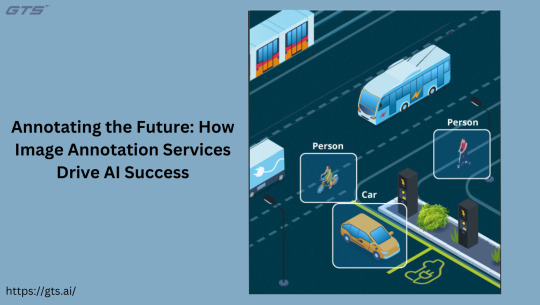
In this fast-paced AI world, the success of any machine-learning system mainly depends on the quality of the data fed into it for exercise. In this journey, image annotation services have emerged to become an essential enabler, transforming raw visual data into structured, labeled datasets. These annotations are the backbone of AI innovations that power facial recognition, autonomous vehicles, e-commerce, healthcare, and beyond.
This blog will discuss how image annotation services are making waves in transforming the landscape for AI by enabling smarter, more accurate models.
What is Image Annotation?
Image annotation is the process of tagging images with labels or metadata to help AI models 'understand' and interpret visual data. Annotated images guide algorithms in identifying objects, classifying images, and predicting with structured data.
Annotated images are crucial because raw data left to itself is unstructured and useless, whereas clarity given to images helps ML systems to perform with much higher accuracy on tasks like object detection, image segmentation, and activity recognition.
Why Image Annotation is Critical for AI Success
Better Training Data, Smarter AI Models: AI systems are, simply put, only as smart as the data they are trained on; annotated images clear the way for the models, setting a foundation on which the models will learn patterns and carry on and make predictions.
Confronting Real-World Complexity: A real-world environment is dynamic and complex. This is where high-quality image annotation ensures that models can work through these complexities, like objects overlapping, changing lighting conditions, or different angles.
Fueling Automation: From retail to robotics, annotated data fuels automation by enabling machines to do mundane tasks like inventory counting, autonomous navigation, and quality checks on assembly lines.
Custom AI Applications: Every industry has its own specific needs; annotation services enable the creation of customized datasets tailored to certain applications.
Core Image Annotation Types
Different types of annotation for various AI applications. Let’s delve deeper into some common techniques thereof:
Object Detection: Tags objects in an image with bounding boxes. Example: Identifying cars, pedestrians, and traffic signs for autonomous vehicles.
Semantic Segmentation: Assigns each pixel in the image to a particular class, thus creating highly-detailed annotations. Example: Classifying road, sidewalk, and vegetation for urban planning.
Keypoint Annotation: Marks certain specified points on the object or human like facial landmarks or joint positions. Example: Tracking facial expressions for emotion detection.
Image Classification: Labeling an entire image based on its primary content. Example: Classifying images of cats, dogs, and birds for a pet identification application.
Polygon Annotation: Outline differently shaped objects to yield accurate labeling results. Example: Defining the boundaries of buildings in satellite imagery.
3D Cuboid Annotation: A 3D view of objects added for applications that require describing depth and dimension. Example: Annotating furniture for Augmented Reality (AR) home design tools.
Applications of Image Annotation Services
The scope of image annotation spans a wide range of industries, each leveraging this technology for innovation and efficiency.
Autonomous Vehicles
Healthcare
Retail and E-Commerce
Agriculture
Security and Surveillance
Entertainment and Media
GTS: Elevating Image Annotation Services
Globose Technology Solutions (GTS) stands out as a leader in providing high-quality image annotation services designed to meet the demands of contemporary AI systems.
Precision and Expertise: GTS utilizes skilled annotators equipped with advanced tools to ensure accurate and consistent outcomes.
Scalable Solutions: Whether you're developing a small AI model or a large-scale enterprise system, GTS delivers scalable annotation services tailored to your requirements.
Data Security: GTS is committed to ethical and secure data handling, strictly following privacy standards.
Multidomain Support: From healthcare to retail, GTS offers annotation solutions across a variety of industries, guaranteeing customized results.
Cutting-Edge Technology: By leveraging AI-assisted tools, GTS accelerates the annotation process while maintaining high quality.
The Future of Image Annotation
The image annotation field is on the brink of exciting developments, with trends set to transform how data is labeled and utilized:
AI-Assisted Annotation: Tools that merge human expertise with AI automation will enhance both efficiency and accuracy.
Synthetic Data Generation: Simulated environments will produce annotated data for situations where obtaining real-world data is challenging.
Edge Annotation: Real-time annotation for edge devices will facilitate applications such as drone surveillance and augmented reality experiences.
Ethical AI: Emphasizing the reduction of bias and the promotion of diversity in annotated datasets will contribute to the creation of more inclusive AI models.
Conclusion
Image annotation is rightfully considered the cornerstone of understanding and processing visual data by an AI model. Accessible through structured datasets, it chimes innovation across various industries to design the future.
Globose Technology Solutions (GTS) is at the head of this evolution, providing accurate, scalable, and secure image annotation services that promise the success of AI. GTS, being committed to quality and innovation, ensures that your AI projects are built upon a strong and sturdy foundation.
The future of AI starts with the right data, and the right data starts with some experienced annotation. Let GTS help you out on that path to success!
0 notes
Text
#data annotation for autonomous vehicles#Image annotation company#3d bounding box annotation#annotation services in india
0 notes
Text
Best Image Annotation Companies Compared: Features, Pricing, and Accuracy

Introduction
As applications powered by artificial intelligence, such as self-driving cars, healthcare diagnostics, and online retail, expand, image annotation has emerged as a crucial component in developing effective machine learning models. However, with numerous providers offering annotation services, how can one select the most suitable Image Annotation Companies for their requirements? In this article, we evaluate several leading image annotation companies in 2025, considering their features, pricing, and accuracy, to assist you in identifying the best match for your project.
1. GTS.AI – Enterprise-Grade Accuracy with Custom Workflows
GTS.AI is renowned for its flexible annotation pipelines, stringent enterprise security standards, and its ability to cater to various sectors such as the automotive, healthcare, and retail industries.
Key Features:
Supports various annotation types including bounding boxes, polygons, keypoints, segmentation, and video annotation.
Offers a scalable workforce that includes human validation.
Integrates seamlessly with major machine learning tools.
Adheres to ISO-compliant data security protocols.
Pricing:
Custom pricing is determined based on the volume of data, type of annotation, and required turnaround time.
Offers competitive rates for datasets requiring high accuracy.
Accuracy:
Achieves over 98% annotation accuracy through a multi-stage quality control process.
Provides annotator training programs and conducts regular audits.
Best for: Companies in need of scalable, highly accurate annotation services across various industries.
2. Labelbox – Platform Flexibility and AI-Assisted Tools
Labelbox provides a robust platform for teams seeking to manage their annotation processes effectively, featuring capabilities that cater to both internal teams and external outsourcing.
Key Features
Include a powerful data labeling user interface and software development kits,
Automation through model-assisted labeling,
Seamless integration with cloud storage and machine learning workflows.
Pricing
Options consist of a freemium tier,
Custom pricing for enterprises,
Pay-per-usage model for annotations.
Accuracy
May vary based on whether annotators are in-house or outsourced, with strong quality
Control tools that necessitate internal supervision.
This platform is ideal for machine learning teams in need of versatile labeling tools and integration possibilities.
3. Scale AI – Enterprise-Level Services for Complex Use Cases
Scale AI is a leading provider in the market for extensive and complex annotation tasks, such as 3D perception, LiDAR, and autonomous vehicle data.
Key Features:
Offers a wide range of annotation types, including 3D sensor data.
Utilizes an API-first platform that integrates with machine learning.
Provides dedicated project managers for large clients.
Pricing
Premium pricing, particularly for high-complexity data.
Offers project-based quotes.
Accuracy:
Renowned for top-tier annotation accuracy.
Implements multi-layered quality checks and human review.
Best for: Projects in autonomous driving, defense, and robotics that require precision and scale.
4. CloudFactory – Human-Centric Approach with Ethical Sourcing
CloudFactory offers a unique blend of skilled human annotators and ethical AI practices, positioning itself as an excellent choice for companies prioritizing fair labor practices and high data quality.
Key Features:
The workforce is trained according to industry-specific guidelines.
It supports annotation for images, videos, audio, and documents.
There's a strong focus on data ethics and the welfare of the workforce.
Pricing
Pricing is based on volume and is moderately priced compared to other providers.
Contracts are transparent.
Accuracy
There are multiple stages of human review.
Continuous training and feedback loops are implemented.
Best for: Companies looking for socially responsible and high-quality annotation services.
5. Appen – Global Crowd with AI Integration

Appen boasts one of the largest international crowds for data annotation, offering extensive support for various AI training data types, such as natural language processing and computer vision.
Key Features
Include a diverse global crowd with multilingual capabilities,
Automated workflows, and data validation tools,
As well as high data throughput suitable for large-scale projects.
Pricing
Appen provides competitive rates for bulk annotation tasks,
With options for pay-as-you-go and contract models.
Accuracy
The quality of data can fluctuate based on project management,
Although the workflows are robust, necessitating a quality control setup.
Best for: This service is ideal for global brands and research teams that need support across multiple languages and domains.
Conclusion: Choosing the Right Partner
The ideal image annotation company for your project is contingent upon your specific requirements:
If you require enterprise-level quality with adaptable services, Globose Technology Solution.AI is recommended.
For those seeking comprehensive control over labeling processes, Labelbox is an excellent choice.
If your project involves intricate 3D or autonomous data, Scale AI is specifically designed for such tasks.
If ethical sourcing and transparency are priorities, CloudFactory should be considered.
For multilingual and scalable teams, Appen may be the right fit.
Prior to selecting a vendor, it is essential to assess your project's scale, data type, necessary accuracy, and compliance requirements. A strategic partner will not only assist in labeling your data but also enhance your entire AI development pipeline.
0 notes
Text
Image Annotation Services: Connecting Raw Data to AI Insights
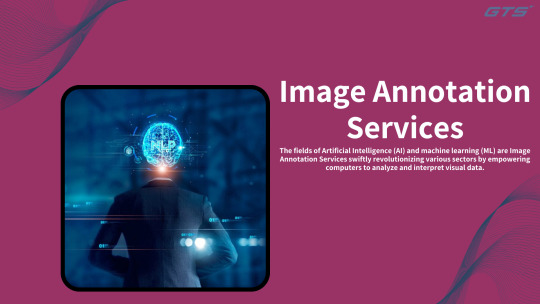
Introduction:
The fields of Artificial Intelligence (AI) and machine learning (ML) are Image Annotation Services swiftly revolutionizing various sectors by empowering computers to analyze and interpret visual data. However, unprocessed images do not offer the structured information necessary for AI to make precise decisions. This is where image annotation services become essential, serving as a link between unrefined image data and valuable AI insights.
Defining Image Annotation
Image annotation involves the process of tagging images with metadata to render them comprehensible for AI algorithms. These tags can identify objects, categorize images, delineate boundaries, or even monitor movements, depending on the specific needs of an AI model. Through accurate annotation, AI systems can identify patterns, recognize objects, and make well-informed decisions with a high degree of precision.
The Significance of Image Annotation for AI
AI models depend on extensive amounts of accurately labeled data for effective learning and enhancement. In the absence of proper image annotation, AI algorithms face challenges in differentiating between objects and accurately interpreting images. The following are some notable advantages of image annotation services:
Increased AI Precision: Well-annotated images facilitate more effective learning for AI, minimizing errors in object detection and classification.
Scalability in AI Development: A substantial volume of labeled data allows AI models to be trained to address a diverse array of real-world situations.
Enhanced Automation: From autonomous vehicles to healthcare diagnostics, annotated images empower AI to automate intricate tasks that necessitate visual recognition.
Improved User Engagement: Technologies such as facial recognition, augmented reality, and e-commerce product suggestions rely on high-quality image annotation to ensure a smooth user experience.
Types of Image Annotation Techniques
Various artificial intelligence applications necessitate distinct annotation techniques. Below are several prevalent types of image annotation utilized in AI training:
Bounding Box Annotation: This method is employed in object detection, where bounding boxes encapsulate objects within an image, facilitating AI in their recognition and classification.
Semantic Segmentation: This approach assigns a label to each pixel in an image, allowing for accurate identification of different areas.
Polygon Annotation: Unlike basic bounding boxes, polygon annotation offers detailed outlines of objects, resulting in more precise labeling.
Keypoint Annotation: This technique is utilized for facial recognition and human pose estimation, marking specific points on an object or human figure.
3D Cuboid Annotation: Vital for applications such as autonomous driving, 3D cuboids enable AI to comprehend depth and spatial relationships.
Applications of Image Annotation Across Industries
Image annotation services play a pivotal role in numerous AI-driven sectors. Some significant applications include:
Autonomous Vehicles: Training self-driving cars to identify pedestrians, traffic signs, and other vehicles.
Healthcare & Medical Imaging: Enhancing AI-based diagnostics through the labeling of X-rays, MRIs, and CT scans.
Retail & E-commerce: Supporting visual search and recommendation systems to improve the shopping experience.
Agriculture: Aiding in crop monitoring, disease detection, and yield estimation through AI-driven analysis.
Security & Surveillance: Enhancing facial recognition and anomaly detection for improved security systems.
Why Opt for Professional Image Annotation Services?
Although some organizations may choose to conduct annotation in-house, utilizing professional image annotation services presents numerous benefits:
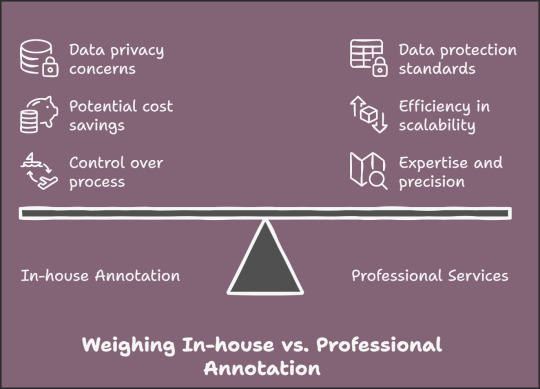
Expertise and Precision: Skilled annotators guarantee accurate labeling, which is crucial for optimal AI functionality.
Efficiency in Time and Costs: By outsourcing annotation tasks, companies can concentrate on AI development while minimizing operational expenses.
Scalability: Professional services are equipped to manage extensive datasets effectively, thereby expediting the AI training process.
Data Protection: Established annotation providers adhere to stringent data privacy standards, safeguarding the confidentiality of sensitive images.
Conclusion
Image annotation services play a vital role in the AI development process, converting unprocessed image data into organized, meaningful information. By connecting raw data with AI insights, these services enable businesses to create more intelligent and efficient AI models across diverse sectors. Whether applied in autonomous vehicles, healthcare, or retail, investing in high-quality image annotation services is a crucial step toward realizing the full potential of AI.
For further information on how image annotation can improve your AI initiative, please visit Globose Technology Solutions AI.
0 notes
Text
Image Data Annotation: The Essential Component of AI and Computer Vision

Introduction:
In the contemporary landscape dominated by artificial intelligence, image data annotation is pivotal in equipping machine learning models to identify and interpret visual data. From self-driving cars to healthcare imaging, image annotation serves as the cornerstone of computer vision technologies. However, what precisely does image data annotation entail, and what makes it so vital?
Defining Image Data Annotation
Image Data Annotation refers to the procedure of tagging images with pertinent metadata to facilitate AI models in comprehending and processing visual information. This process includes the assignment of labels, tags, or delineations to objects within images, rendering them appropriate for supervised learning algorithms. By training on these annotated images, machine learning models can recognize patterns, categorize objects, and generate informed predictions.
Types of Image Data Annotation
Different annotation techniques are employed depending on the specific application and the complexity of the AI model. Some of the most prevalent types include:
Bounding Box Annotation
This technique involves drawing rectangular boxes around objects within an image.
It is frequently utilized in object detection for applications such as self-driving vehicles, retail, and security.
Semantic Segmentation
This method assigns a label to each pixel in an image.
It is particularly beneficial for advanced applications, including medical imaging and autonomous navigation.
Polygon Annotation
This approach employs irregular shapes to more accurately define the boundaries of objects compared to bounding boxes.
It is advantageous for annotating objects with intricate shapes, such as animals or human figures.
Keypoint and Landmark Annotation
This technique identifies specific points within an image, including facial features, joints, or other landmarks.
It is essential for applications like facial recognition and pose estimation.
3D Cuboid Annotation
This method extends bounding boxes into three-dimensional space to capture depth and perspective.
It is applied in fields such as augmented reality and robotics.
Polyline and Lane Annotation
This technique involves drawing lines to identify roads, lanes, or boundaries.
It is crucial for applications in autonomous driving and urban planning.
The Growing Importance of Image Data Annotation
The need for high-quality image annotation services is increasingly evident across multiple sectors. Notable applications include:
Autonomous Vehicles: Facilitates the ability of AI systems to identify pedestrians, traffic signs, and various obstacles.
Healthcare & Medical Imaging: Assists AI in recognizing tumors, irregularities, and diseases within medical imaging.
E-commerce & Retail: Improves product search capabilities, recommendation algorithms, and inventory oversight.
Security & Surveillance: Enhances facial recognition, behavioral analysis, and the detection of anomalies.
Agriculture: Supports monitoring of crops, identification of pests, and forecasting of yields.
Challenges Associated with Image Data Annotation

Despite its significance in AI advancement, image annotation presents several challenges:
Accuracy & Consistency: Achieving precise labeling necessitates the involvement of skilled annotators and thorough quality assurance processes.
Time-Intensive Nature: The manual annotation of extensive datasets can be both laborious and costly.
Scalability Challenges: Large-scale annotation requires effective workforce management and the implementation of automation solutions.
Privacy & Ethical Considerations: The management of sensitive information, such as medical images or personal photographs, mandates strict adherence to privacy laws and regulations.
The Evolution of Image Data Annotation
The landscape of image annotation is undergoing significant transformation due to advancements in artificial intelligence and automation. Organizations are increasingly utilizing AI-enhanced annotation tools, active learning methodologies, and crowdsourcing platforms to enhance both efficiency and precision. Furthermore, services such as GTS AI provide scalable and high-quality solutions for image and video annotation, specifically designed for applications in AI and machine learning.
As artificial intelligence continues to progress, the necessity for accurate and efficient image data annotation is expected to rise. Investing in superior annotation services will be crucial for fostering innovation in AI-driven applications across various sectors.
Concluding Remarks
Image data annotation serves as a fundamental component of computer vision and artificial intelligence. Whether applied in autonomous vehicles, healthcare, or e-commerce, accurately annotated images empower AI models to make informed and intelligent decisions. By utilizing professional annotation services and cutting-edge AI techniques, organizations can expedite their Globose Technology Solutions initiatives and explore new opportunities in the digital landscape.
0 notes
Text
What to Expect from a Leading Image Annotation Company
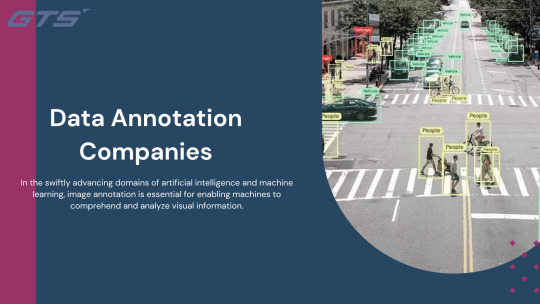
Introduction:
In the swiftly advancing domains of artificial intelligence and machine learning, image annotation is essential for enabling machines to comprehend and analyze visual information. For organizations engaged in developing AI models, collaborating with a premier image annotation firm can significantly impact their success. However, what distinguishes the top companies in this field? Here are the key attributes you should anticipate from a high-caliber image annotation service provider.
Proficiency in Various Annotation Methods
A premier Image Annotation Company should provide an extensive array of annotation services customized for different industries and applications. These services may encompass:
Bounding Boxes: Ideal for object detection and localization.
Semantic Segmentation: Involves assigning pixel-level labels to objects for sophisticated applications such as autonomous driving.
Keypoint Annotation: Suitable for facial recognition and human pose estimation.
Polygon Annotation: Effective for annotating irregular shapes within images.
3D Point Cloud Annotation: Essential for processing LiDAR data in robotics and autonomous vehicles.
Such comprehensive proficiency guarantees that your specific project needs are addressed with accuracy.
Scalability and Rapid Turnaround
Reputable annotation firms recognize the importance of time in AI development. They possess the necessary infrastructure and resources to manage large-scale annotation projects without sacrificing precision. Whether dealing with thousands or millions of images, they should be capable of scaling their operations and delivering results within the established timelines.
Cutting-Edge Tools and Technology
Leading firms utilize advanced annotation tools and software to ensure both efficiency and accuracy. They may also employ AI-assisted annotation platforms to expedite the labeling process while upholding high-quality standards. Seek providers that prioritize investment in innovative technology to optimize workflows and improve output.
Rigorous Quality Assurance Protocols
Accuracy is essential in image annotation. A premier company will establish comprehensive quality control protocols, including multi-tiered reviews and automated verification processes, to reduce the likelihood of errors. Anticipate thorough testing procedures to guarantee that the annotated data aligns with the specific requirements of your project.
Tailored Solutions
Each AI project possesses its own distinct characteristics, and a top-tier image annotation firm recognizes this. They should be capable of customizing their offerings to meet your particular needs, whether that entails following stringent guidelines, managing sensitive information, or integrating seamlessly with your current systems and workflows.
Data Protection and Privacy
In the context of proprietary or sensitive information, security is imperative. Leading firms emphasize data protection by employing secure systems, complying with international standards (such as GDPR), and entering into non-disclosure agreements (NDAs). Their dedication to privacy ensures that your data remains secure throughout the annotation process.
Skilled Workforce
A proficient team of annotators and project managers is the backbone of every successful annotation initiative. Top companies recruit trained professionals who possess experience in managing a variety of datasets. Their knowledge contributes to maintaining consistency and precision, even in intricate annotation assignments.
Open Communication and Support
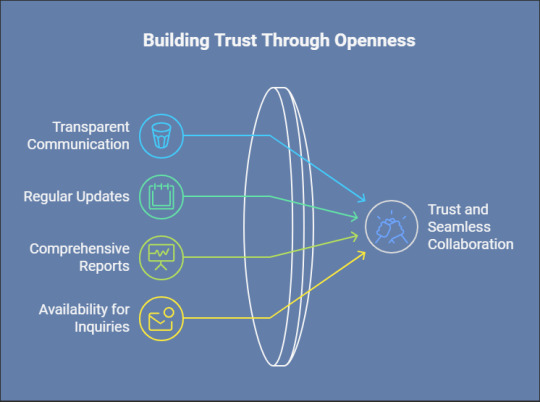
A trustworthy image annotation partner prioritizes transparent and effective communication. They offer regular updates, comprehensive reports, and are readily available to address any inquiries without delay. This level of openness fosters trust and facilitates a seamless collaboration.
Affordable Services
While maintaining quality is paramount, leading companies also aim to provide competitive pricing. By streamlining their operations and utilizing advanced technologies, they offer high-quality annotation services at a reasonable price, ensuring excellent value for your investment.
A Demonstrated History of Success
In conclusion, a reputable image annotation firm will possess a track record of completed projects and contented clients. It is advisable to seek out case studies, client testimonials, and examples from their portfolio that highlight their proficiency and capability to achieve results across diverse sectors.
Conclusion
Collaborating with a distinguished image annotation company such as GTS.AI can greatly improve the effectiveness of your AI models. By providing specialized knowledge, scalability, cutting-edge tools, and a dedication to quality, these firms lay the groundwork for successful AI and machine learning endeavors. It is essential to select a partner who fulfills these criteria and aligns with the objectives of your project to ensure optimal results.
For those seeking a reliable collaborator in image annotation, GTS AI provides extensive services customized to meet your specific requirements. With proficiency in multiple fields and a dedication to quality, GTS AI guarantees that your AI models attain exceptional performance.
0 notes